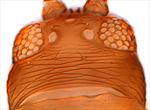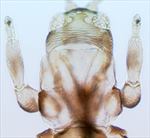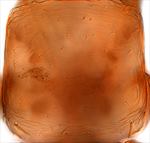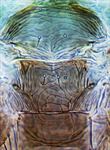
Female

Head

Antenna

Head & pronotum

Pronotum

Mesonotum & metanotum

Fore wing

Abdominal tergites V–VI

Male sternites III–VI
Both sexes fully winged. Body yellow to light brown, distal antennal segments darkest, fore wings pale. Antennae 8-segmented, III & IV with short forked sense cone. Head relatively large, with 3 pairs of ocellar setae, pair III just outside ocellar triangle; compound eye with 6 pigmented ommatidia; mouth cone unusually elongate. Pronotum with one pair of long posteroangular setae. Metanotum reticulate, median setae small, far back from anterior margin. Fore wing first vein with 3 setae on distal half, second vein with about 10 setae; posteromarginal cilia strongly wavy. Tergites with transverse lines of sculpture medially, VIII without a marginal comb or craspedum; tergite X not longer than IX. Sternites III–IV each with one very small glandular area anteromedially.
Male with sternites III–VI bearing circular to oval pore plate; tergite IX with 2 pairs of stout thorn-like setae medially.
Three species were described from North America in the genus Chilothrips, but Zhang et al. (2018) synonymised that genus with Oxythrips. The two species from California described by Stannard (1973), O. occidentalis and O. rotrameli, both have the tenth abdominal tergite exceptionally elongate, whereas C. pini was described from Maryland with a more normal tenth tergite. The only specimens from California that have been studied by the present authors agree with the character states given for C. pini. In view of the variation in length of the tenth tergite within a population of O. strobilus in China (Cui et al., 2017), there is a possibility that the two species from California are the same as the one from Maryland. Bailey (1957: 189) recorded the European species Oxythrips quercicola Bagnall from Pinus and Quercus in California, but subsequent examination of Bailey's specimens indicates that this was a misidentification although the identity of his species remains unknown.
Living on Pinus species, including Pinus virginianus [Pinaceae], and presumably breeding in male cones and feeding on pollen.
Widely recorded from Maryland, Wisconsin, and California.
THRIPIDAE - THRIPINAE
Chilothrips pini Hood, 1916: 120
Bailey SF (1957) The thrips of California Part I: Suborder Terebrantia. Bulletin of California Insect Survey 4: 143–220.
Cui YZ, Xi JH & Wang J (2017) Female polymorphism in Chilothrips strobilus (Thysanoptera: Thripidae), with the first description of the male. Zootaxa 4358 (1): 193–196.
Stannard LJ (1973) Two new species of Chilothrips (Thysanoptera: Thripidae). Journal of the Kansas entomological Society 46: 107–115.
Zhang SM, Wang ZH, Li YJ & Mound LA (2018) One new species, two generic synonyms and eight new records of Thripidae from China (Thysanoptera). Zootaxa 4418 (4): 370–378.